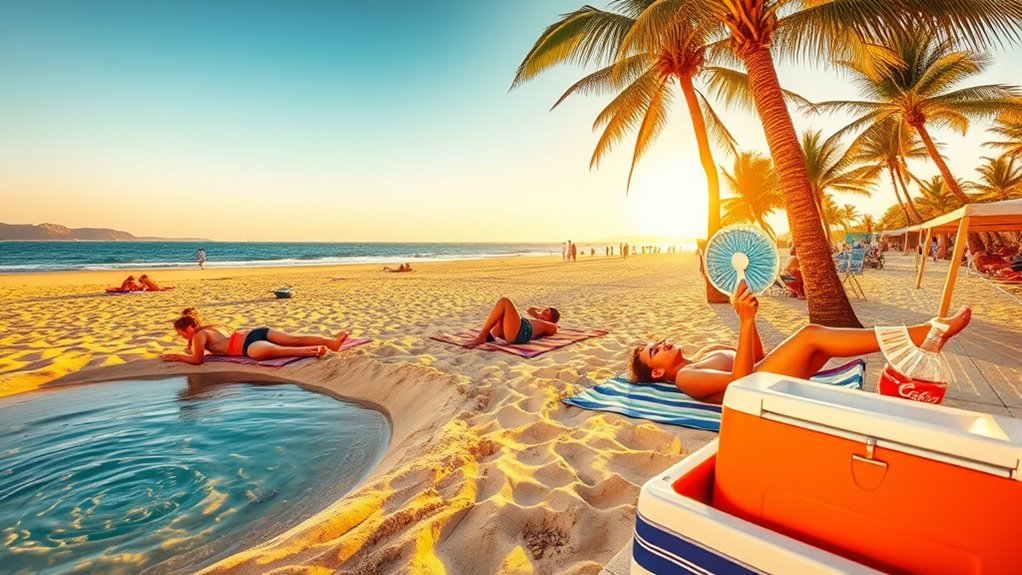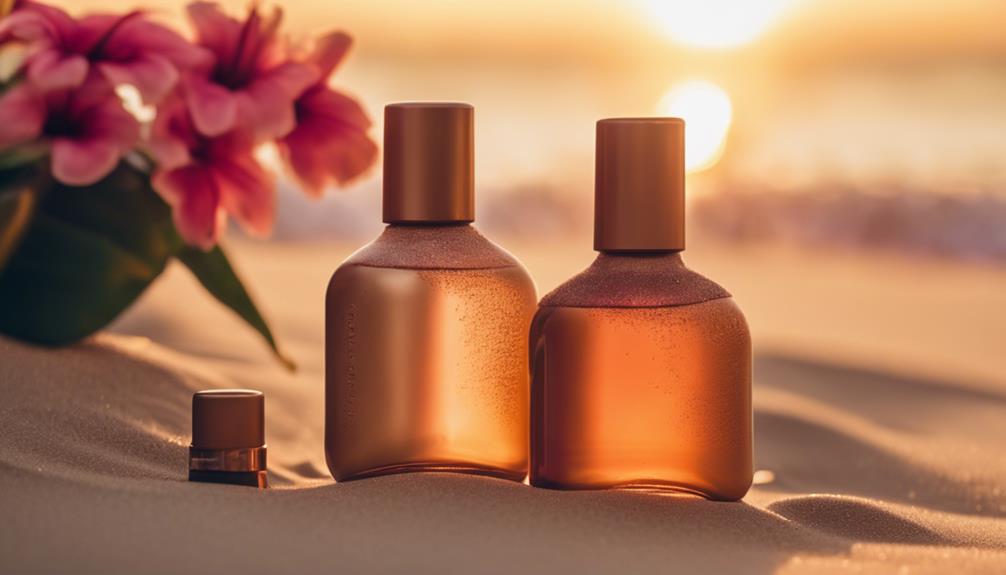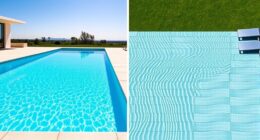To cool down quickly on the sand, seek shade immediately and use a damp cloth on your forehead, neck, or wrists for fast relief. Dip your feet in cool water, and splash cold water on your face or neck to lower your body temperature. Wear lightweight, breathable clothing and drink cold water or sports drinks regularly. Taking breaks in shady spots and using natural evaporative methods can also help. Keep exploring for more effective ways to stay safe and comfortable.
Key Takeaways
- Seek immediate shade or create your own with umbrellas or towels to reduce sun exposure.
- Dip your feet in cool water to lower body temperature and promote circulation.
- Use damp cloths on forehead, neck, or wrists for rapid cooling and relief.
- Splash cold water on your face and neck or apply cold packs for quick temperature reduction.
- Wear lightweight, breathable clothing and take regular breaks in shaded areas to prevent overheating.
Find Shade Quickly
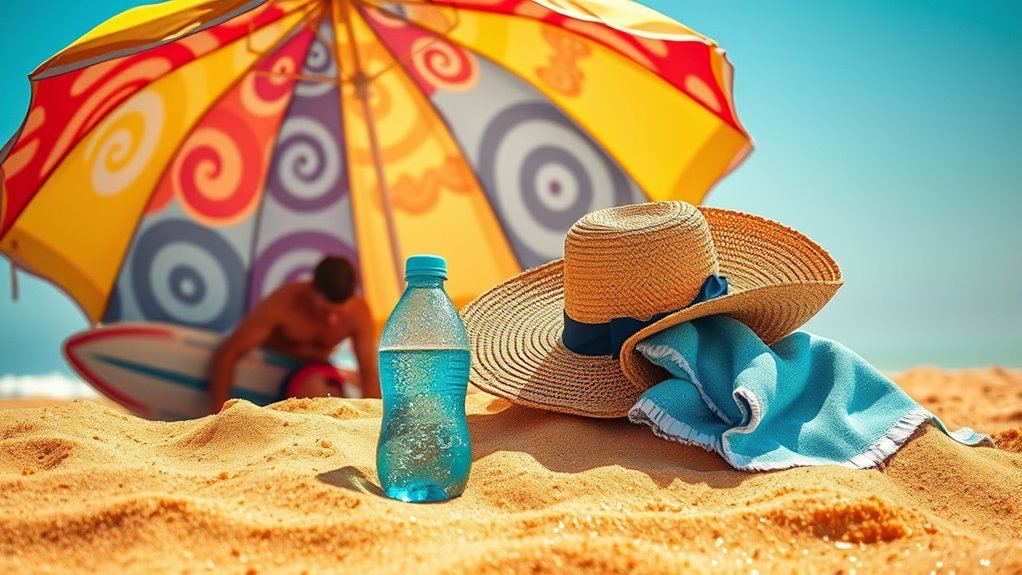
When the heat becomes overwhelming, finding shade quickly can make a big difference in cooling down. Look for a shade shelter, like a large beach umbrella, a tree, or a man-made structure. These provide essential sun protection, shielding you from direct sunlight and reducing your body temperature. Act fast—staying in the sun for too long can cause dehydration and heat exhaustion. If you can’t find natural shade, create your own with a portable canopy or a towel over your head. Remember, the goal is to block the sun’s rays as soon as possible. Staying in shaded areas not only cools you down but also helps prevent sunburn and long-term skin damage. Implementing effective heat mitigation strategies can help you stay safe and comfortable on the sand. Additionally, being aware of seasonal variations can help you anticipate the best times to seek shade and avoid the hottest parts of the day. Using proper shading techniques can further improve your cooling efforts and provide longer-lasting relief. Recognizing the importance of dog breed traits can also inform decisions on how best to keep your pet comfortable in hot weather.
Dip Your Feet in Cool Water
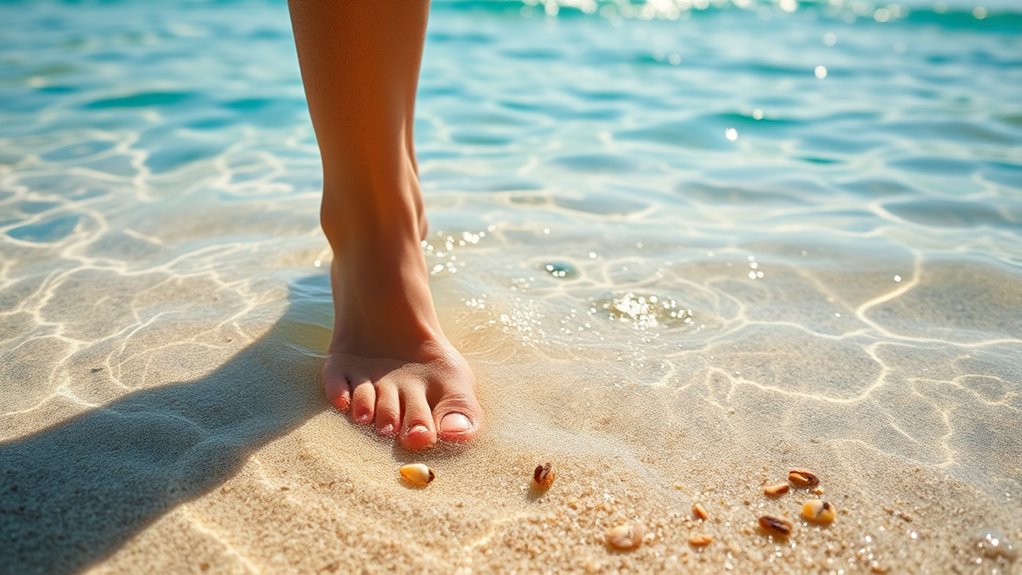
dipping your feet in cool water provides immediate relief and helps lower your body temperature naturally. It’s a simple, quick fix you can do anytime, anywhere, with minimal effort. This easy method offers instant comfort when you need it most. Incorporating this into your routine can also be a fun way to enjoy a scenic view while cooling down. Additionally, using data privacy strategies like this can improve your overall comfort during hot days and prevent overheating.
Refreshing Relief for Feet
If your feet feel hot and exhausted after a long day, immersing them in cool water provides quick relief. As you dip your feet, take a moment for a gentle foot massage to boost circulation and ease tension. While cooling, consider your footwear choice—wearing breathable shoes or sandals helps maintain the invigorating sensation longer. Keep your feet submerged for a few minutes, allowing the cool water to lower your skin temperature and reduce swelling. Afterward, dry your feet thoroughly and apply a moisturizer to keep skin healthy. Regularly using air purifiers can also improve indoor air quality, creating a more comfortable environment for relaxation. Proper maintenance and cleaning of your air purifier ensures it functions effectively, contributing to a healthier indoor space. This simple step not only cools down your feet instantly but also enhances comfort, making it easier to relax on the sand. Incorporating personal comfort devices like cooling foot pads can further extend the soothing effects. Quick, effective, and easy—your feet will thank you.
Natural Temperature Drop
Plunging your feet into cool water is one of the quickest ways to lower your body temperature naturally. As you do so, you instinctively seek shade, aiding your temperature regulation. The water absorbs heat from your skin, creating a soothing contrast to the sun’s heat. Imagine this scene:
| Shade Seeking | Cool Water Dip |
|---|---|
| Protects you from direct sunlight | Evaporates heat from your skin |
| Keeps your body cooler | Instantly refreshes you |
| Promotes comfort | Speeds up temperature regulation |
| Encourages rest in shade | Provides quick relief |
This simple act helps your body cool down efficiently, making shade seeking and water dipping your best natural temperature drop strategies. Proper spray tip selection can also help prevent overheating during outdoor painting in hot weather. Incorporating sunscreen can further protect your skin from UV rays while you cool down. Additionally, understanding the benefits of thermoregulation can help optimize your cooling methods in hot environments. Recognizing how body heat transfer occurs can further enhance your cooling strategies and comfort.
Easy and Instant Use
When you need quick relief from heat, dipping your feet into cool water is one of the simplest and fastest methods available. It instantly lowers your body temperature and offers immediate comfort, especially on hot sand. This easy and instant trick helps you stay comfortable without complex equipment or waiting. Just make certain the water isn’t too cold, as extreme temperatures can cause discomfort or shock. For sand comfort, keep in mind that wet feet can make walking more stable and prevent slipping. Always prioritize beach safety by avoiding deep or fast-moving water, and be aware of your surroundings. This quick dip keeps you refreshed, minimizes heat exhaustion risk, and lets you enjoy your time on the sand longer.
Use a Wet Cloth or Towel
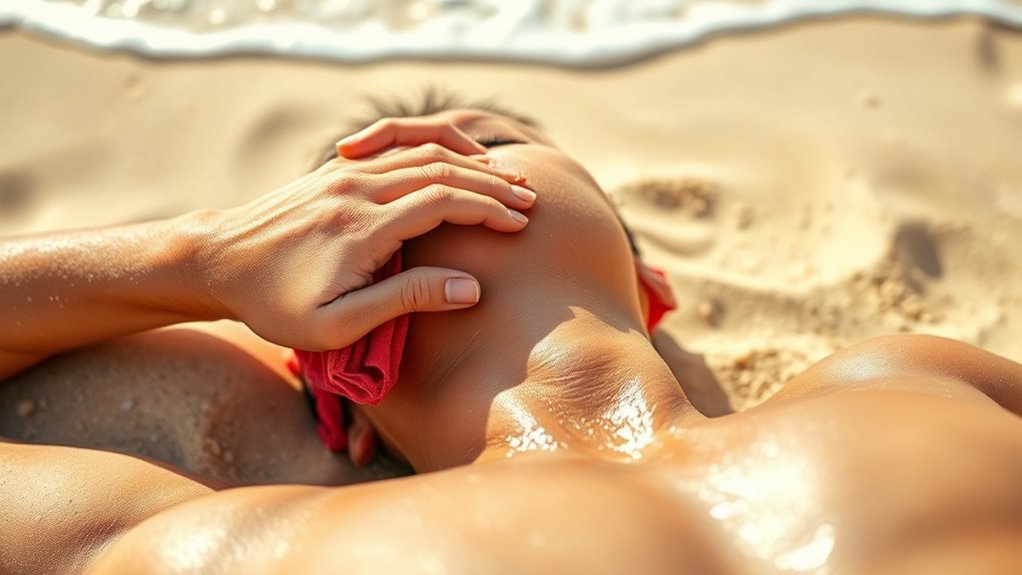
A damp cloth or towel can quickly help you feel cooler when you’re overheated. Applying it to your forehead or neck provides immediate relief and enhances the cooling effect. Chill the cloth beforehand for extra comfort and faster results. Using body temperature regulation to monitor your body’s response can help optimize your cooling strategies. Additionally, ensure proper hydration, as staying well-hydrated supports thermal comfort and overall cooling efficiency.
Damp Towel Application
Using a damp towel or wet cloth is an effective way to quickly lower your body temperature. A cooling towel or damp cloth can be placed on your neck, forehead, or wrists for rapid relief. The cool moisture accelerates heat transfer from your skin, helping you feel cooler faster. To visualize, consider this table:
| Body Area | Towel Type | Effect |
|---|---|---|
| Neck | Cooling towel | Reduces core temperature |
| Forehead | Damp cloth | Eases heat stress |
| Wrists | Damp cloth | Promotes cooling |
Apply the damp cloth to these key areas, re-wetting as needed. This simple method is quick, portable, and effective, especially on hot sand where heat absorption intensifies. Additionally, conducting sound therapy can enhance relaxation and recovery after heat exposure. Incorporating proper hydration alongside these cooling strategies can further improve your comfort and safety in hot environments.
Chill for Relief
Applying a wet cloth or towel directly to your skin offers quick, targeted relief from heat stress. The cool sensation helps lower your body temperature rapidly, especially on hot sand. To enhance cooling, you can also use an air purifier to improve air quality in nearby shelters, helping you breathe easier and feel more comfortable. For even better results, sip on ice cold drinks to hydrate and cool your core. If possible, seek out an air conditioned shelter to give your body a break from the sun’s heat. Keep the damp cloth on pulse points like your wrists, neck, or forehead for maximum cooling. This simple method provides immediate relief and can be easily combined with drinking cold beverages or taking a break indoors. Remember, staying hydrated and avoiding prolonged sun exposure are essential to prevent heat exhaustion while enjoying the sand. Incorporating cooling techniques like shade structures and proper ventilation can further enhance comfort during hot days. Utilizing advancements in heat management can also help you stay cooler more effectively.
Enhance Cooling Effect
To boost the cooling effect of a wet cloth or towel, focus on guaranteeing maximum contact with your skin. Keep the cloth snug against your body to transfer heat efficiently. For added comfort, position yourself in an area with good air circulation; this helps sweat evaporate faster, intensifying the cooling process. Using cooling accessories like a fan or handheld mister nearby can further enhance the effect. Re-wet the towel frequently to maintain its coolness, and consider flipping it to expose a cooler surface. Properly managing contact and airflow ensures you get the most from your wet cloth, helping you cool down quicker on the sand. Combining these tactics maximizes your cooling strategy and keeps you comfortable longer.
Apply Ice Packs or Cold Items
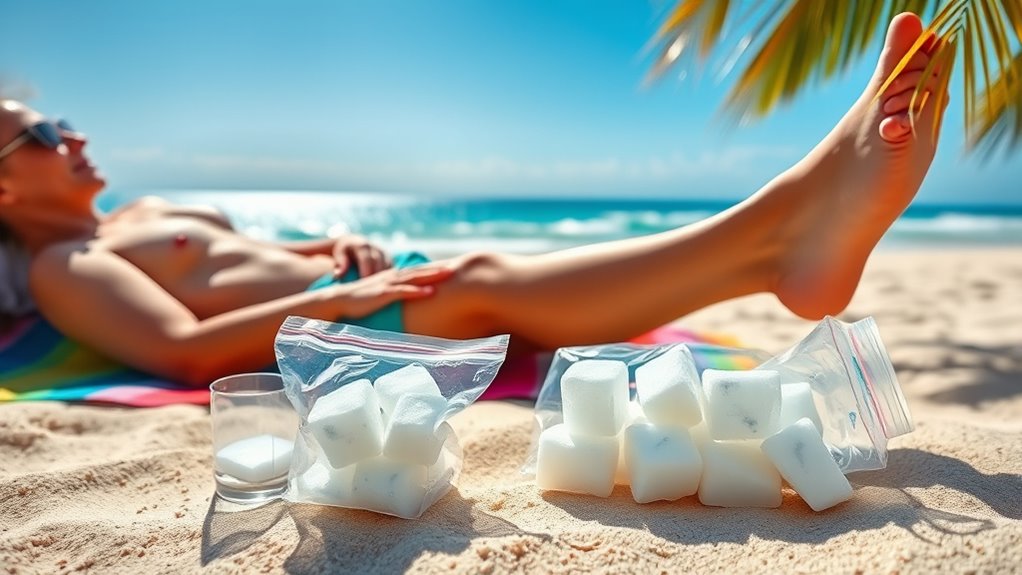
When you experience a sudden injury or swelling, placing an ice pack or cold item directly on the affected area can quickly reduce inflammation and numb pain. Use ice packs or cold items like chilled towels or gel packs for effective relief. Make certain you wrap ice packs in a cloth to prevent frostbite and avoid direct skin contact. Applying cold for 15-20 minutes at a time helps control swelling without causing tissue damage.
| Cold Item | Usage Tip |
|---|---|
| Ice packs | Wrap in cloth before applying |
| Frozen vegetables | Use as a quick, portable cold pack |
| Gel packs | Keep in freezer and use as needed |
| Chilled towels | Apply directly for gentle cooling |
This method offers fast relief, especially on the sand.
Drink Cold Beverages Regularly
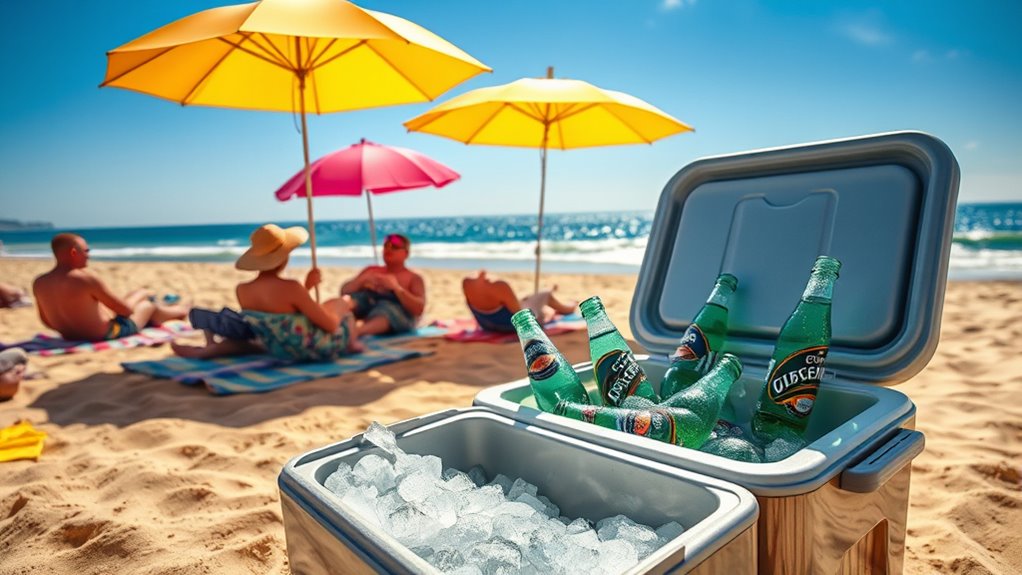
Drinking cold beverages regularly can help keep your body temperature down and prevent overheating, especially during hot weather or after physical activity. Your beverage choices matter—opt for drinks like water, sports drinks, or chilled fruit juices to maximize cooling effects. To stay effectively hydrated, follow these tips:
- Sip small amounts frequently rather than large gulps.
- Consume cold beverages before, during, and after activity.
- Choose beverages with electrolytes to replenish lost salts.
- Keep drinks chilled and readily available on the sand.
Timing your hydration is key; don’t wait until you’re thirsty. Regularly drinking cold beverages maintains your core temperature and keeps you feeling comfortable in the heat. Stay consistent to avoid dehydration and overheating.
Splash Water on Your Face and Neck
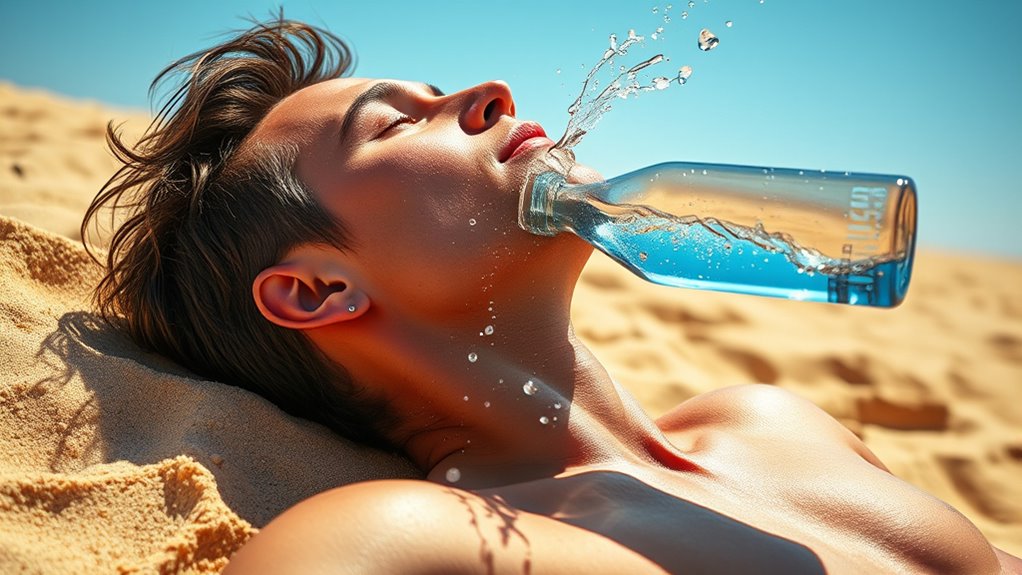
Splashing water on your face and neck offers quick relief from heat and helps lower your body temperature. A simple face splash refreshes your skin and cools the blood vessels, giving you an immediate feeling of relief. When you do a face splash, make sure to cup your hands and splash cold water onto your cheeks, forehead, and around your eyes. A neck splash targets a major blood vessel close to the surface, helping to cool your core quickly. Tilt your head back slightly and pour water over your neck, focusing on the sides and front. This simple action can make a noticeable difference in how hot you feel, giving you a quick, effective way to stay cool while you’re on the sand.
Wear Light, Breathable Clothing
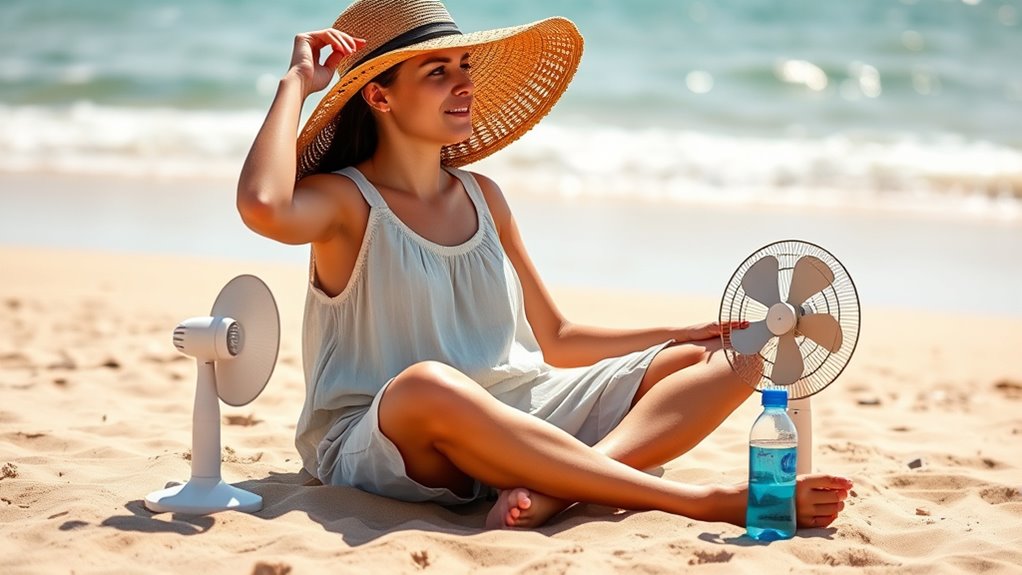
Choosing light, breathable clothing helps you stay cool by allowing air to circulate and moisture to evaporate more efficiently. This improves sand comfort and provides better sun protection, reducing the risk of overheating. To maximize these benefits:
- Wear loose-fitting fabrics that promote airflow.
- Opt for light colors that reflect sunlight rather than absorb it.
- Choose clothing made of moisture-wicking materials to keep sweat away.
- Cover your skin with lightweight, long-sleeved shirts or hats for added sun protection.
Take a Break From Direct Sunlight
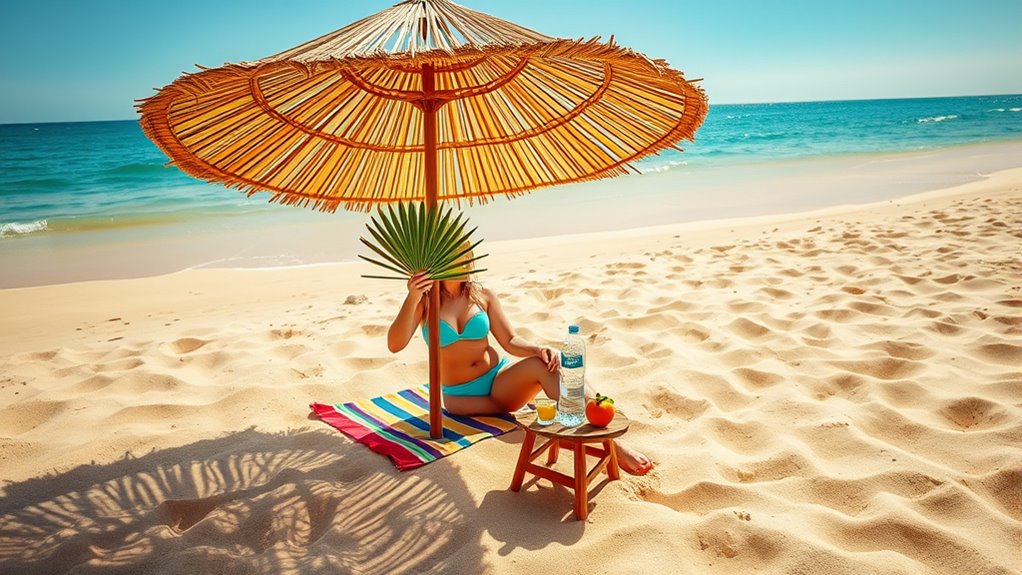
Since prolonged exposure to direct sunlight can quickly raise your body temperature and lead to heat exhaustion, it’s important to take regular breaks in shaded areas or indoors. Look for shade options like umbrellas, canopies, or natural shade from trees. These provide effective sun protection and help lower your risk of overheating. During breaks, step out of direct sunlight completely to allow your body to cool down. Use sun protection measures such as wearing a wide-brimmed hat or UV-blocking sunglasses if you stay in shaded areas. Avoid staying in the sun for too long without a break, especially during peak hours. Taking regular shade breaks keeps your body temperature down and reduces fatigue, making your time on the sand safer and more enjoyable.
Use Natural Evaporative Cooling Techniques
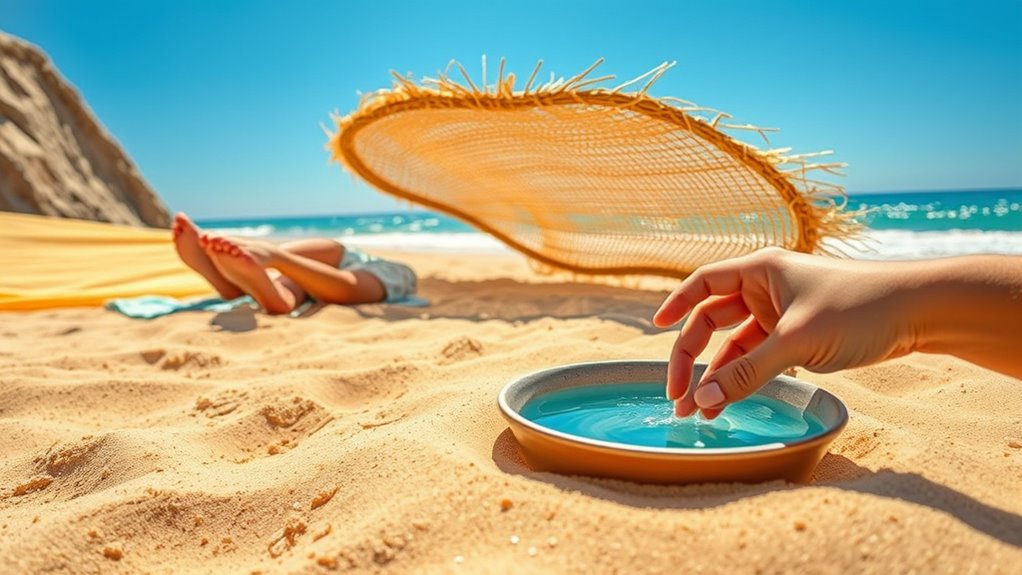
Using natural evaporative cooling techniques can effectively reduce your body temperature in hot conditions. To maximize evaporative cooling, you can use natural insulation to keep yourself cool. Consider these methods:
Maximize cooling by using natural insulation and evaporative techniques in hot conditions.
- Splash water on your skin and let it evaporate, cooling you down quickly.
- Use a damp cloth or bandana around your neck or forehead to promote evaporative cooling.
- Wet your clothes or hat slightly for ongoing natural insulation and cooling.
- Find shaded areas or create shade with a towel or cloth to enhance evaporative cooling and minimize heat absorption.
These techniques leverage evaporative cooling and natural insulation to keep you comfortable on the sand. They’re simple, effective, and require minimal effort, making them ideal for quick cool-downs.
Frequently Asked Questions
How Long Should I Stay in the Shade for Effective Cooling?
When considering shade duration, you should stay in the shade for at least 10-15 minutes to guarantee effective cooling. This allows your body temperature to decrease gradually and helps prevent heat exhaustion. Keep in mind, the cooling effectiveness depends on your activity level and the shade’s quality. You might need longer if you’re very hot or have been exerting yourself. Stay hydrated and listen to your body’s signals.
Can I Reuse Cold Water or Ice Packs Multiple Times?
Ever wonder if you can reuse ice packs or cold water? Yes, you can, but it’s best to verify if your ice pack is reusable and keep it clean. For cold water conservation, refill your water bottles instead of using fresh ice packs each time. Reusing ice packs and cold water helps save resources and keeps you cool longer. Just ensure your packs are properly sanitized before reuse for safety.
Are There Specific Clothing Materials Best for Hot Weather?
When dealing with hot weather, you should choose clothing made from moisture-wicking fabrics that draw sweat away from your skin, keeping you cooler and more comfortable. UV protective clothing is also a smart option, as it shields you from harmful sun rays. Opt for lightweight, breathable materials, and avoid cotton, which traps heat. These choices help you stay cool, dry, and protected during hot days.
How Often Should I Hydrate During Intense Heat Exposure?
During intense heat exposure, you should hydrate frequently, roughly every 15-20 minutes, to maintain hydration frequency and support electrolyte balance. Drinking small amounts often helps prevent dehydration and keeps your energy levels steady. Pay attention to your body’s signals, like thirst and dizziness, and include electrolyte drinks if you’re sweating heavily. Consistent hydration guarantees you stay hydrated and safe while enjoying your time outdoors.
Is It Safe to Use Fans or Portable Coolers on the Sand?
They say “better safe than sorry,” and that applies here. Using fans or portable coolers on the sand can be safe if you prioritize fan safety, ensuring they’re stable and protected from sand and moisture. Cooler effectiveness depends on placement and insulation. Keep fans away from direct water or sand, and always follow manufacturer guidelines. Proper use helps you stay cool without risking damage or injury in the heat.
Conclusion
Staying cool on the sand is simple with these quick strategies. Did you know that your body temperature can rise by up to 5°F in just 15 minutes of sun exposure? By finding shade, hydrating, and using cool compresses, you can prevent heat exhaustion and enjoy your time at the beach safely. Remember, a few easy steps can make all the difference in keeping you comfortable and safe under the sun.

